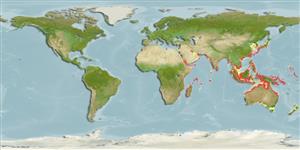Common names from other countries
Environment: milieu / climate zone / depth range / distribution range
Ekologi
marina; amfidrom (Ref. 51243); djupintervall 5 - 100 m (Ref. 52753). Tropical; 40°N - 12°S, 47°E - 143°E
Indo-West Pacific.
Length at first maturity / Size / Vikt / Age
Maturity: Lm 21.0 range ? - ? cm
Max length : 31.6 cm TL hane/ej könsbestämd; (Ref. 121654)
Taggstrålar i ryggfenan (totalt) : 9; Mjukstrålar i ryggfenan (totalt) : 21 - 22; Taggstrålar i analfenan: 3; Mjukstrålar i analfenan: 17 - 18. This species is easily recognized by its long pelvic fin which fit into a groove along the midline of the belly when depressed. Scutes are present along its straight lateral line. Adult males have prolonged middle rays in the soft dorsal and anal fins. This species attains 25 cm in SL.
Adults are common in shallow coastal waters where they often swim near the surface. They feed mainly on shrimps, copepods, decapod crustaceans and small fish.
Life cycle and mating behavior
Maturities | Reproduktion | Spawnings | Egg(s) | Fecundities | Larver
Masuda, H., K. Amaoka, C. Araga, T. Uyeno and T. Yoshino, 1984. The fishes of the Japanese Archipelago. Vol. 1. Tokai University Press, Tokyo, Japan. 437 p. (text). (Ref. 559)
IUCN Red List Status (Ref. 130435)
CITES (Ref. 128078)
Not Evaluated
Threat to humans
Harmless
Human uses
Fiskeri: mindre kommeriell
Verktyg
Special reports
Download XML
Internet-källor
Estimates based on models
Preferred temperature (Ref.
115969): 23.5 - 29.2, mean 28.2 (based on 1522 cells).
Phylogenetic diversity index (Ref.
82804): PD
50 = 1.0000 [Uniqueness, from 0.5 = low to 2.0 = high].
Bayesian length-weight: a=0.02089 (0.01183 - 0.03689), b=2.87 (2.72 - 3.02), in cm Total Length, based on LWR estimates for this species & (Sub)family-body (Ref.
93245).
Trofisk nivå (Ref.
69278): 3.6 ±0.52 se; based on food items.
Resiliens (Ref.
120179): Hög, lägsta populationsfördubblingstid mindre än 15 månader (Preliminary K or Fecundity.).
Fishing Vulnerability (Ref.
59153): Low vulnerability (18 of 100).
